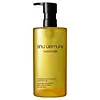What's inside
What's inside
 Key Ingredients
Key Ingredients

 Benefits
Benefits

 Concerns
Concerns

 Ingredients Side-by-side
Ingredients Side-by-side

Zea Mays Germ Oil
EmollientEthylhexyl Palmitate
EmollientIsopropyl Myristate
EmollientCaprylic/Capric/Succinic Triglyceride
EmollientPolyglyceryl-6 Dioleate
EmulsifyingPolyglyceryl-6 Dicaprate
EmulsifyingPrunus Armeniaca Kernel Oil
MaskingPolyglyceryl-2 Oleate
EmulsifyingPolyglyceryl-6 Caprylate
EmulsifyingLavandula Hybrida Oil
EmollientLimonene
PerfumingCitrus Nobilis Peel Oil
MaskingPelargonium Graveolens Flower Oil
MaskingLinalool
PerfumingCupressus Sempervirens Leaf/Nut/Stem Oil
EmollientTocopherol
AntioxidantCitronellol
PerfumingCitrus Limon Peel Oil
MaskingGeraniol
PerfumingOriganum Majorana Leaf Oil
MaskingZingiber Officinale Root Oil
MaskingMentha Piperita Oil
MaskingCitral
PerfumingWater
Skin ConditioningDicaprylyl Ether
EmollientDicaprylyl Carbonate
EmollientUndecane
EmollientCymbopogon Schoenanthus Oil
MaskingGlycine Soja Oil
EmollientTridecane
PerfumingGlyceryl Stearate Citrate
EmollientOryza Sativa Bran Oil
EmollientMaltodextrin
AbsorbentCitrus Junos Fruit Extract
Skin ConditioningHelianthus Annuus Seed Oil
EmollientZea Mays Germ Oil, Ethylhexyl Palmitate, Isopropyl Myristate, Caprylic/Capric/Succinic Triglyceride, Polyglyceryl-6 Dioleate, Polyglyceryl-6 Dicaprate, Prunus Armeniaca Kernel Oil, Polyglyceryl-2 Oleate, Polyglyceryl-6 Caprylate, Lavandula Hybrida Oil, Limonene, Citrus Nobilis Peel Oil, Pelargonium Graveolens Flower Oil, Linalool, Cupressus Sempervirens Leaf/Nut/Stem Oil, Tocopherol, Citronellol, Citrus Limon Peel Oil, Geraniol, Origanum Majorana Leaf Oil, Zingiber Officinale Root Oil, Mentha Piperita Oil, Citral, Water, Dicaprylyl Ether, Dicaprylyl Carbonate, Undecane, Cymbopogon Schoenanthus Oil, Glycine Soja Oil, Tridecane, Glyceryl Stearate Citrate, Oryza Sativa Bran Oil, Maltodextrin, Citrus Junos Fruit Extract, Helianthus Annuus Seed Oil
Glycine Soja Oil
EmollientCorylus Avellana Seed Oil
EmollientSorbeth-30 Tetraoleate
EmulsifyingVitis Vinifera Seed Oil
EmollientOlea Europaea Fruit Oil
MaskingCaprylic/Capric Triglyceride
MaskingSqualane
EmollientIsoamyl Laurate
EmollientCamellia Japonica Seed Oil
EmollientOenothera Biennis Oil
EmollientSimmondsia Chinensis Seed Oil
EmollientHelianthus Annuus Seed Oil
EmollientArgania Spinosa Kernel Oil
EmollientOrbignya Oleifera Seed Oil
EmollientSaponaria Officinalis Leaf Extract
AntimicrobialCamellia Sinensis Leaf Extract
AntimicrobialOryza Sativa Bran Oil
EmollientRice Ferment Filtrate
Skin ConditioningDecyl Glucoside
CleansingGinkgo Biloba Leaf Extract
Skin ConditioningLavandula Angustifolia Oil
MaskingAloe Barbadensis Leaf Extract
EmollientCitrus Aurantium Dulcis Oil
MaskingMelaleuca Alternifolia Leaf Oil
AntioxidantTocopherol
AntioxidantGlycine Soja Oil, Corylus Avellana Seed Oil, Sorbeth-30 Tetraoleate, Vitis Vinifera Seed Oil, Olea Europaea Fruit Oil, Caprylic/Capric Triglyceride, Squalane, Isoamyl Laurate, Camellia Japonica Seed Oil, Oenothera Biennis Oil, Simmondsia Chinensis Seed Oil, Helianthus Annuus Seed Oil, Argania Spinosa Kernel Oil, Orbignya Oleifera Seed Oil, Saponaria Officinalis Leaf Extract, Camellia Sinensis Leaf Extract, Oryza Sativa Bran Oil, Rice Ferment Filtrate, Decyl Glucoside, Ginkgo Biloba Leaf Extract, Lavandula Angustifolia Oil, Aloe Barbadensis Leaf Extract, Citrus Aurantium Dulcis Oil, Melaleuca Alternifolia Leaf Oil, Tocopherol
 Reviews
Reviews

Ingredients Explained
These ingredients are found in both products.
Ingredients higher up in an ingredient list are typically present in a larger amount.
Glycine Soja Oil comes from the soybean. Glycine Soja is native to eastern Asia.
Soybean oil is an emollient. It is rich in antioxidants and fatty acids including palmitic, stearic, oleic, and linoleic acids.
As an emollient, the fatty acids in soybean oil helps keep your skin soft and hydrated. It does so by creating a film on top that traps moisture in.
Soybean oil is also rich in vitamin E, a potent antioxidant. Vitamin E is also anti-inflammatory and provides a soothing effect.
Studies show soy may help fade hyperpigmentation from UVB. It does so by disrupting the melanin process from UVB induced skin inflammation.
This ingredient may not be malassezia folliculitis, or fungal-acne, safe.
Soybeans are rich in proteins and are part of the legume family. Foods made with soybeans include tofu, soymilk, edamame, miso, and soy sauce.
Learn more about Glycine Soja OilHelianthus Annuus Seed Oil is the oil derived from the seeds of a Sunflower. Sunflower seed oil is non-fragrant. It is an emollient, meaning it helps to soften the skin.
Sunflower seed oil contains many fatty acids. The fatty acids found in sunflower seeds include (from highest amount to least): linoleic acid, myristic acid, palmitic acid, stearic acid, arachidic acid, oleic acid, and linolenic acid.
These fatty acids help the skin create ceramides. Ceramides play a role in repairing the skin barrier.
Helianthus Annuus Seed Oil helps moisturize the skin. This in turn helps the skin look more rejuvenated and smoother.
Sunflowers are rich in vitamin E.
Historians believe Indigenous cultures of North America domesticated sunflowers before corn. Thus they relied on sunflower oil for a variety of uses. One such use is moisturizing skin and hair.
Sunflower seed oil may not be fungal acne safe. We recommend speaking with a professional if you have any concerns.
Learn more about Helianthus Annuus Seed OilOryza Sativa Bran Oil comes from the outer layer of a rice kernel. It is a byproduct of milling rice, or the operation to produce a whole grain rice product.
This ingredient has emollient and skin conditioning properties. This is due to its polysaccharides and omega-3 fatty acids.
Emollients help soothe and soften the skin. It does this by creating a protective film on your skin. This barrier helps trap moisture and keeps your skin hydrated.
Learn more about Oryza Sativa Bran OilTocopherol (also known as Vitamin E) is a common antioxidant used to help protect the skin from free-radicals and strengthen the skin barrier. It's also fat soluble - this means our skin is great at absorbing it.
Vitamin E also helps keep your natural skin lipids healthy. Your lipid skin barrier naturally consists of lipids, ceramides, and fatty acids. Vitamin E offers extra protection for your skin’s lipid barrier, keeping your skin healthy and nourished.
Another benefit is a bit of UV protection. Vitamin E helps reduce the damage caused by UVB rays. (It should not replace your sunscreen). Combining it with Vitamin C can decrease sunburned cells and hyperpigmentation after UV exposure.
You might have noticed Vitamin E + C often paired together. This is because it is great at stabilizing Vitamin C. Using the two together helps increase the effectiveness of both ingredients.
There are often claims that Vitamin E can reduce/prevent scarring, but these claims haven't been confirmed by scientific research.
Learn more about Tocopherol